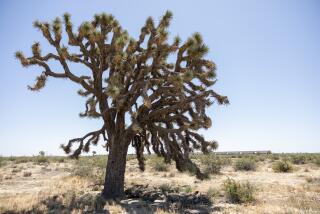Jojoba Growers Struggling : Dreams of Desert Miracle Crop Spoiled
- Share via
TUCSON — Jojoba oil. Pronounced like Santa’s chuckle, jojoba is a desert evergreen that a decade ago was going to help save the sperm whale and make a generation of entrepreneurial farmers rich.
So much for big dreams. It has made it into shampoos, but the biology of this bush and the economics of industry crops have stumped all but the most dedicated jojoba supporters.
“I’m broke,” said Carole Whittaker, president of Hyder Jojoba Inc. in Phoenix, who after 10 years still struggles to meet production and harvesting costs. “No one has ever made money from the production of jojoba.”
Many jojoba investors didn’t know what they were in for. From a peak of 45,000 acres, there are now 25,000 acres of active jojoba plantations in the United States, Whittaker said. The shakeout may continue, now that tax advantages have been eliminated.
“A lot was said about jojoba that wasn’t true,” said David A. Palzkill, assistant professor of plant science at the University of Arizona in Tucson. “There’s still a lot not known about jojoba.”
Disappointing Results
Promoters boasted that this new-found crop didn’t need water or fertilizer and would bring in $10,000 an acre. That attracted many people who lacked agricultural experience and who found out too late that, without water and fertilizer, the amount of seed produced is unpredictable, said Palzkill.
Instead of getting at least 1,500 pounds of seed per acre as some predicted, jojoba growers get about 900--in good years. In 1987, the yields fell so short that about half the 400 tons of oil produced came from seeds collected from wild plants.
It takes time to convert a wild plant into a crop, and that transition takes even longer when the crop, like jojoba, is a perennial, Palzkill said. From seed to seed-producing plant takes four years. Only then can growers and scientists begin to find out whether a new variety produces more seeds more reliably. It takes even longer to determine the best amount and timing for irrigation and fertilization.
Jojoba is an oddity, both as a crop and as a desert plant. It is native to California, Arizona and Mexico. It keeps its small, oval grey-green leaves year-round, even in the worst weather. The bush grows three to 12 feet tall.
Most oil crops, such as sunflowers, are annuals. Jojoba lives for decades.
During the early 1970s when sperm oil was embargoed, researchers began exploring the potential of jojoba oil as a substitute and as an industry for American Indians.
The oil that accounts for 50% of the jojoba seed is unique. Its molecular structure is different from other seed oils. The oil is odorless and colorless and never gets rancid.
Shampoos, skin creams, soaps, cosmetics, even transmission fluid additives have jojoba oil as one ingredient. At first it was a marketing gimmick. “Now they are using it for its value as a product,” Palzkill said.
More to Read
Inside the business of entertainment
The Wide Shot brings you news, analysis and insights on everything from streaming wars to production — and what it all means for the future.
You may occasionally receive promotional content from the Los Angeles Times.










